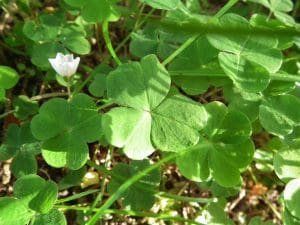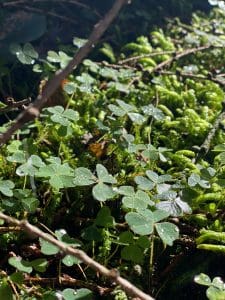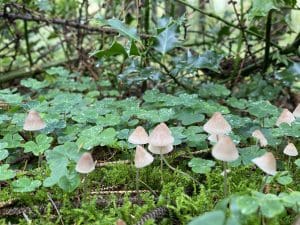Wood Sorrel / Summer / Autumn / Winter / Edible
Common Names
Wood sorrel, cuckoo sorrel, sleeping Molly, Alleluia
Botanical Name
Oxalis acetosella
Scientific Classification
Kingdom – Plantae
Order –Oxalidales
Family – Oxalidaceae
Wood Sorrel Foraging Video
Physical Characteristics
This common perennial can grow in large patches connected by subterranean rhizomes, with the ability to produce by seed and by rhizome.
Leaf
On each delicate red-tinged stem, there is a clump of three leaves growing together from 5-10cms in length. Each leaf collection is made up of three heart-shaped leaflets, each leaf has a neat fold down the center which changes, opening, and closing dependent on the amount of light available.

Flowers
This plant amazingly has two types of flower, its first set of flowers from deep purple to white with distinct purple-white veins, are incredibly attractive, opening up and inviting many bumblebees. The second set of flowers that appear later in the year are called cleistogamous flower, these are very small, remaining fully closed and will self-pollinate. The flowers have five petals in a bell shape.
Habitat
UK, Most of Europe (specifically Northern), Northern America, and most of Asia. It grows in damp woods and shady places, and as such can be much more common towards the North and West where the woods are generally wetter! The kind of wood where mosses are growing up the tree trunks are ideal.
Known Hazards
This plant contains Oxalic acid, similar to Rhubarb, giving it its sour taste, if you ingest too much of this acid you can upset your stomach. Saying that you would have to eat a serious amount of Wood sorrel to get to this point. To be avoided by anyone with kidney disease, kidney stones, rheumatoid arthritis, or gout.
Could be confused with
Clover – the clump of three leaves are a little like those found on a Clover, the main difference being that a Clover leaf sits flat whereas a Sorrel leaf has a distinct fold down the centre of the leaf, making each leaf almost look like those of a butterfly. Clover leaves are also oval or round instead of heart shaped, and often have a pale mark on them which Wood Sorrel doesn’t have. Finally, the two plants are unlikely to be in the same place, as Clover prefers full sun and Wood Sorrel deep shade.
Edible Use
Leaves: Edible salads, sauces, smoothies, juiced, cakes, icing
Flower: All of the above
Notes on Herbal uses
It’s a diuretic and has antiscorbutic properties as well as having a great cooling ability. It’s been used to calm stomach upsets.
Extra notes from the Foragers
The common Wood Sorrel is sometimes referred to as a Shamrock and given as a gift on Saint Patrick’s Day. This is due to its trifoliate clover-like leaf, and to early references to Shamrock being eaten. Despite this, it is generally accepted that the plant described as “true” Shamrock is a species of Clover, usually Lesser Clover (Trifolium dubium).
References
https://en.wikipedia.org/wiki/Oxalis_acetosella












